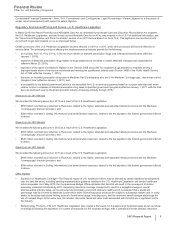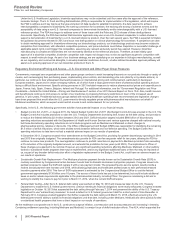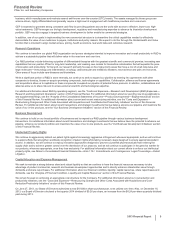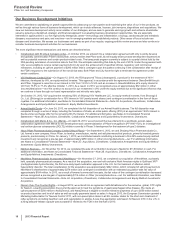Pfizer 2013 Annual Report Download - page 16
Download and view the complete annual report
Please find page 16 of the 2013 Pfizer annual report below. You can navigate through the pages in the report by either clicking on the pages listed below, or by using the keyword search tool below to find specific information within the annual report.
Financial Review
Pfizer Inc. and Subsidiary Companies
2013 Financial Report
15
Specifically:
• When we estimate the fair value of our five biopharmaceutical reporting units as in effect prior to our January 1, 2014 reorganization we
rely solely on the income approach. We use the income approach exclusively as many of our products are sold in multiple reporting units
and as one reporting unit is geographic-based while the others are product and/or customer-based. Further, the projected cash flows
from a single product may reside in up to three reporting units at different points in future years and the discounted cash flow method
would reflect the movement of products among reporting units. As such, the use of the comparable guideline company method is not
practical or reliable. For the income approach, we use the discounted cash flow method.
• When we estimate the fair value of our Consumer Healthcare reporting unit, we use a combination of approaches and methods. We use
the income approach and the market approach, which we weight equally in our analysis. We weight them equally as we have equal
confidence in the appropriateness of the approaches for this reporting unit. For the income approach, we use the discounted cash flow
method and for the market approach, we use both the guideline public company method and the guideline transaction method, which we
weight equally to arrive at our market approach value.
While all reporting units can confront events and circumstances that can lead to impairment, we do not believe that the risk of goodwill
impairment for any of our reporting units as of December 31, 2013, is significant at this time.
Our Consumer Healthcare reporting unit has the narrowest difference between estimated fair value and estimated book value. However, we
believe that it would take a significant negative change in the undiscounted cash flows, the discount rate and/or the market multiples in the
consumer industry for the Consumer Healthcare reporting unit goodwill to be impaired. Our Consumer Healthcare reporting unit performance
and consumer healthcare industry market multiples are highly correlated with the overall economy and our specific performance is also
dependent on our and our competitors’ innovation and marketing effectiveness, and on regulatory developments affecting claims, formulations
and ingredients of our products.
For all of our reporting units, there are a number of future events and factors that may impact future results and that could potentially have an
impact on the outcome of subsequent goodwill impairment testing. For a list of these factors, see the “Forward-Looking Information and
Factors That May Affect Future Results” section of this Financial Review and Part I. Item 1A "Risk Factors" in our 2013 Annual Report on Form
10-K.
Benefit Plans
The majority of our employees worldwide are covered by defined benefit pension plans, defined contribution plans or both. In the U.S., we
have both qualified and supplemental (non-qualified) defined contribution and defined benefit plans, as well as other postretirement benefit
plans consisting primarily of healthcare and life insurance for retirees (see Notes to Consolidated Financial Statements—Note 1P. Basis of
Presentation and Significant Accounting Policies: Pension and Postretirement Benefit Plans and Note 11. Pension and Postretirement Benefit
Plans and Defined Contribution Plans). Beginning on January 1, 2011, for employees hired in the U.S. and Puerto Rico after December 31,
2010, we no longer offer a defined benefit plan and, instead, offer an enhanced benefit under our defined contribution plan. In addition to the
standard matching contribution by the Company, the enhanced benefit provides an automatic Company contribution for such eligible
employees based on age and years of service. Also, on May 8, 2012, we announced to employees that as of January 1, 2018, Pfizer will
transition its U.S. and Puerto Rico employees from its defined benefit plans to an enhanced defined contribution savings plan.
The accounting for benefit plans is highly dependent on actuarial estimates, assumptions and calculations, which result from a complex series
of judgments about future events and uncertainties. The assumptions and actuarial estimates required to estimate the employee benefit
obligations for the defined benefit and postretirement plans may include the discount rate; expected salary increases; certain employee-related
factors, such as turnover, retirement age and mortality (life expectancy); and healthcare cost trend rates.
As of December 31, 2013, our Pension benefit obligations, net and our Postretirement benefit obligations, net declined, in the aggregate, by
approximately $4.0 billion compared to December 31, 2012. The decline reflects, among other things, a significant increase in our discount
rate assumptions, used in the measurement of the plan obligations, as well as the impact of a strong return on plan assets for plans with
assets.
Our assumptions reflect our historical experiences and our judgment regarding future expectations that have been deemed reasonable by
management. The judgments made in determining the costs of our benefit plans can materially impact our results of operations.
The following table provides the expected versus actual rate of return on plan assets and the discount rate used to measure the benefit
obligations for our U.S. qualified pension plans and our international pension plans(a):
2013 2012 2011
U.S. Qualified Pension Plans
Expected annual rate of return on plan assets 8.5% 8.5% 8.5%
Actual annual rate of return on plan assets 11.3 12.7 3.4
Discount rate used to measure the plan obligations 5.2 4.3 5.1
International Pension Plans
Expected annual rate of return on plan assets 5.8 5.6 5.9
Actual annual rate of return on plan assets 13.1 9.6 2.7
Discount rate used to measure the plan obligations 3.9 3.8 4.7
(a) For additional assumptions associated with our benefit plans, see Notes to Consolidated Financial Statements—Note 11B. Pension and Postretirement Benefit
Plans and Defined Contribution Plans: Actuarial Assumptions.
























